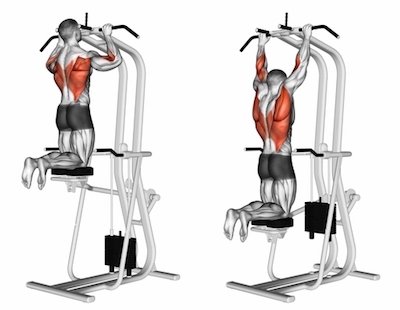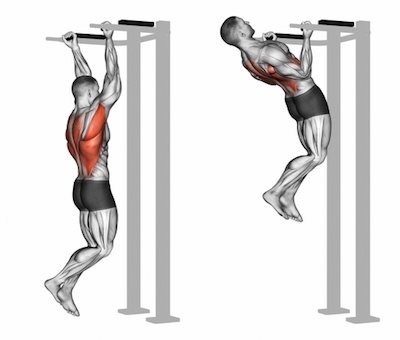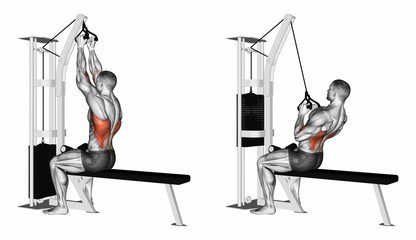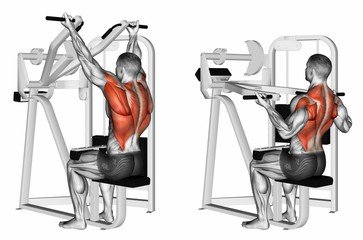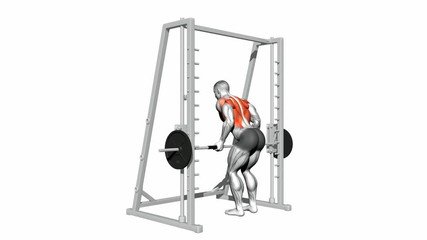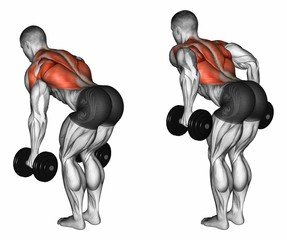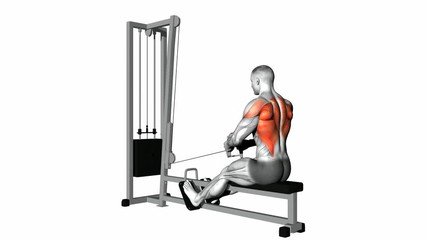Wide Grip Overhand Chin Ups
Take a wide grip on the the pull-up bar and let your body hang free. This is the starting position.
Bending from the elbows and exhaling as you do, pull the body up to the maximum height you can. Your torso should travel in a straight line vertically which closes the angle between your upper arm and the sides of your body. Minimise momentum and swing throughout the movement to maintain focus on the correct muscle group.
Squeeze for a brief second at the top of the movement before lowering your body back to the starting position, inhaling as you do.
Assisted Wide Grip Overhand Chin Ups
Pin a suitable weight to support your body without removing all difficulty from the lift.
Take a wide grip on the the pull-up bar and pop one knee at a time up onto the support pad. Then let your body hang straight down. This is the starting position.
Bending from the elbows and exhaling as you do, pull the body up to the maximum height you can. Your torso should travel in a straight line vertically which closes the angle between your upper arm and the sides of your body. Minimise momentum and swing throughout the movement to maintain focus on the correct muscle group.
Squeeze for a brief second at the top of the movement before lowering your body back to the starting position, inhaling as you do.
Dismount by taking one knee off the support pad then placing that foot on the ground. Keeping your hands on either the chin handles or the parallel bars, use your other knee and body weight to slowly let the support pad come back to its resting position. You can then bring the other knee off.
Close-Grip Underhand Chin-Ups
Take an underhand grip on the the pull-up bar just inside of shoulder-width and let your body hang down. Creating a small reverse curvature in the lower back before commencing the movement will help to keep the focus on the target muscle rather than carrying all of your body weight through your biceps. This is the starting position.
Pull the chest up through your arms to the maximum height you can, closing the angle at the elbows and exhaling as you do. The elbows remain close to the body. Minimise momentum and swing throughout the movement to maintain focus on the correct muscle group.
Squeeze for a brief second at the top of the movement before lowering your body back to the starting position, inhaling as you do.
Close Grip V-Bar Pulldown
Take grip on the the V-bar handle such that your palms face each other. Now lock your thighs under the knee rolls to prevent you from lifting your butt off the seat. Feet should be flat on the floor and your arms now extended. This is the starting position.
Commence the movement by pulling the bar down and squeezing your shoulder blades together. As you bend your elbows, exhale and push your chest through the movement. This will naturally create a reverse curvature in the lower back and will engage the target muscles of the lats.
When the bar just touches your chest, squeeze for a second and then reverse the movement by extending the arms to the starting position, inhaling as you do.
Underhand Grip Lat Pulldown Machine
Take an underhand grip on the machine handles such that your palms face backward. Now lock your thighs under the knee support to prevent you from lifting your butt off the seat. Angle your torso back just slightly and keep your chest popped out, not collapsed. Feet should be flat on the floor and your arms now extended. This is the starting position.
Commence the movement by pulling the bar down and squeezing your shoulder blades together. As you move the elbows down and back, keep them close to your body while you exhale and push your chest through the movement. This will naturally create a reverse curvature in the lower back and will engage the target muscles of the lats. Do not swing backward or try to use momentum to pull the bar.
When you have reached maximum range of motion at the bottom, squeeze for a second and then reverse the movement by extending the arms to the starting position, inhaling as you do.
Wide Overhand Grip Lat Pulldown
Take a wide, overhand grip on the bar such that your palms face forward. Now lock your thighs under the knee rolls to prevent you from lifting your butt off the seat. Angle your torso back just slightly and keep your chest popped out, not collapsed. Feet should be flat on the floor and your arms now extended. This is the starting position.
Commence the movement by pulling the bar down and squeezing your shoulder blades together. As you bend your elbows, exhale and push your chest through the movement. This will naturally create a reverse curvature in the lower back and will engage the target muscles of the lats. Do not swing backward or try to use momentum to pull the bar.
When the bar just touches your chest, squeeze for a second and then reverse the movement by extending the arms to the starting position, inhaling as you do.
Narrow Underhand Grip Lat Pulldown
Take a narrow, underhand grip on the bar such that your palms face backward. Now lock your thighs under the knee rolls to prevent you from lifting your butt off the seat. Angle your torso back just slightly and keep your chest popped out, not collapsed. Feet should be flat on the floor and your arms now extended. This is the starting position.
Commence the movement by pulling the bar down and squeezing your shoulder blades together. As you move the elbows down and back, keep them close to your body while you exhale and push your chest through the movement. This will naturally create a reverse curvature in the lower back and will engage the target muscles of the lats. Do not swing backward or try to use momentum to pull the bar.
When the bar just touches your chest, squeeze for a second and then reverse the movement by extending the arms to the starting position, inhaling as you do.
Wide Underhand Grip Lat Pulldown
Take a wide, underhand grip on the bar such that your palms face backward. Now lock your thighs under the knee rolls to prevent you from lifting your butt off the seat. Angle your torso back just slightly and keep your chest popped out, not collapsed. Feet should be flat on the floor and your arms now extended. This is the starting position.
Commence the movement by pulling the bar down and squeezing your shoulder blades together. As you move the elbows down and back, keep them close to your body while you exhale and push your chest through the movement. This will naturally create a reverse curvature in the lower back and will engage the target muscles of the lats. Do not swing backward or try to use momentum to pull the bar.
When the bar just touches your chest, squeeze for a second and then reverse the movement by extending the arms to the starting position, inhaling as you do.
Overhand Grip Barbell Bent Over Rows
Take an overhand grip on a barbell, just outside of shoulder-width. You may lift the barbell from the ground however for heavier lifts, setting up in the squat rack can be beneficial.
Your feet should be planted firmly, knees bent slightly. Your core is tight and your torso is angled forward from the waist but making sure not to arch your back over. Keeping your head up, take the weight of the barbell and let your arms hang down perpendicular to the floor. This is the starting position.
Commence the movement by pulling the bar up and back, squeezing your shoulder blades together. The elbows are not flared - keep them close to your body while you exhale through the movement. Do not use momentum to pull the bar. The torso should remain stationary.
When the bar just touches your abdomen, squeeze for a second and then reverse the movement by extending the arms to the starting position, inhaling as you do.
Underhand Grip Smith Machine Bent Over Rows
Take an shoulder-width, underhand grip on the Smith Machine bar.
Your feet should be planted firmly, knees bent slightly. Your core is tight and your torso is angled forward from the waist but making sure not to arch your back over. Keeping your head up, take the weight of the barbell and let your arms hang down perpendicular to the floor. This is the starting position.
Commence the movement by pulling the bar up and back, squeezing your shoulder blades together. The elbows are not flared - keep them close to your body while you exhale through the movement. The torso should remain stationary.
When the bar just touches your abdomen, squeeze for a second and then reverse the movement by extending the arms to the starting position, inhaling as you do.
Incline Bench Barbell Rows
Set your bench to an incline of around 30 degrees. Lie face down onto the bench with your chest sitting at the top point of the bench and your arms hanging fully extended toward the floor.
Take an overhand-grip on a barbell, just outside of shoulder-width. Your core is tight and you use your lower body to stablise you. Depending on your height, you may either pop your feet to the floor and come up onto your toes. Others feel more comfortable having their knees instead up onto the seat rest. This is the starting position.
Commence the movement by pulling the bar up and back, squeezing your shoulder blades together and flaring the elbows out to the sides. Exhale through the movement and keep your torso should stationary. It should not be lifting off the bench. Think of the movement like a "reverse barbell chest press".
Squeeze for a second at the top of the motion and then reverse the movement by extending the arms to the starting position, inhaling as you do.
Incline Bench Dumbbell Rows
Set your bench to an incline of around 30 degrees. Lie face down onto the bench with your chest sitting at the top point of the bench and your arms hanging fully extended toward the floor.
Take an overhand grip on a some suitable weight dumbbells. Your core is tight and you use your lower body to stabilise you. Depending on your height, you may either pop your feet to the floor and come up onto your toes. Others feel more comfortable having their knees instead up onto the seat rest. This is the starting position.
Commence the movement by pulling the dumbbells up and back, squeezing your shoulder blades together and flaring the elbows out to the sides. Exhale through the movement and keep your torso should stationary. It should not be lifting off the bench. Think of the movement like a "reverse dumbbell chest press".
Squeeze for a second at the top of the motion and then reverse the movement by extending the arms to the starting position, inhaling as you do.
Dumbbell Bent Over Rows
Take hold of some suitable weight dumbbells. Plant your feet firmly just inside shoulder-width, knees bent slightly. Your core is tight and your torso is angled forward from the waist but making sure not to arch your back over. Keep your head up and let your arms hang down perpendicular to the floor, palms facing each other holding the weight. This is the starting position.
Commence the movement by pulling up and back with the elbows, squeezing your shoulder blades together. The elbows are not flared - keep them close to your body while you exhale through the movement. The torso should remain stationary.
When you have maximum retraction of the elbows, squeeze for a second and then reverse the movement by extending the arms to the starting position, inhaling as you do.
T-Bar Rows
Plant your feet firmly on the foot pads of the machine, knees bent slightly. Your core is tight and your torso is angled forward from the waist but making sure not to arch your back over. Take an overhand-grip on the T-bar handles.
Take the weight of the bar, let your arms hang down perpendicular to the floor but keep your head up. This is the starting position.
Commence the movement by pulling the bar up and back, squeezing your shoulder blades together. The elbows are flared out as you squeeze your middle back while exhaling through the movement. The torso should remain stationary. Do not jerk the bar up.
When the elbows are back as far as you can take them, squeeze for a second and then reverse the movement by extending the arms to the starting position, inhaling as you do.
Seated Cable Row
Plant your feet firmly on the foot pads of the machine, knees bent slightly. Lean forward from the waist and grip the V-bar handles so that your palms face each other.
Taking the weight of the cable with your extended arms, lean back until your back is at 90 degrees to the bench. Your chest should be sticking out which will create a slight reverse arch in your lower back. This is the starting position.
Commence the movement by pulling the V-bar toward your abdomen and squeezing your shoulder blades together. The elbows remain tight in by your sides rather than flaring out. The torso should remain stationary while you exhale through the movement. You should not be rocking forward and backward like a cardio row machine.
When the elbows are back as far as you can take them and the bar is against your abdomen, squeeze for a second and then reverse the movement by extending the arms to the starting position, inhaling as you do.



